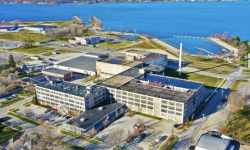Q&A: ‘Grand Rapids is going to be the benchmark’ for Michigan growth

- West Michigan stands out in the state for its ability to grow both population and jobs
- One area of success is increasing how many educated young professionals live in the region
- Among the region’s 10-year goals is to increase tech jobs, and it’s on track to reach that
Amid Michigan’s well-known population struggles, the state’s second-largest city has been the hub for west Michigan’s standout growth over the past several years
The Grand Rapids region accomplishes that by focusing on big projects — like the recently announced $700 million soccer stadium and amphitheater that will anchor new housing and retail in Grand Rapids — along with steady job growth from key sectors, including technology and manufacturing.
Randy Thelen, CEO of economic development group The Right Place, describes 2024 as a good year for the Grand Rapids region, which includes Kent County and seven nearby counties.

The group’s year-end report notes accomplishments including:
- 6.1% increase in population over the last decade of “greater Grand Rapids” to about 1.1 million
- Nearly 40,000 tech sector workers.
- A higher concentration of young people as a share of the population compared to the nation.
The area also is the top-rated mid-sized metro in the state, according to national rankings for job and population growth by Business Facilities magazine, with the area coming in tied with Columbus, Colorado Springs and Salt Lake City for population growth.
In comparison, the most recent national population data for Michigan shows a one-year gain of 57,103 people, or 0.6%, largely due to international immigration. However, longer-term forecasts say the gains will end in a few years and result in declines by 2050.
Thelen spoke recently with Bridge business editor Paula Gardner. Here are excerpts from the conversation.
Where is your growth coming from?
The region added just over 5,000 jobs (in 2024, reaching a total of 591,000.) Roughly half of that growth came from two sectors, manufacturing and tech.
The striving for efficiency through automation is constant in manufacturing. So to be able to see job growth there is a really good signal for economic health.
Related:
- For booming Grand Rapids, a larger ambition: Midwest technology hub
- $700M plan to 'transform' Grand Rapids with soccer arena, concert districts
- Another real estate shortage: Grand Rapids running out of industrial space
- West Michigan reverses Chicago exodus, gaining residents as state stagnates
And then on the tech side, the goal we set (in 2022) is to grow our economy from 6% tech-based to 10% tech -based. And to do that, we need to add about 20,000 jobs over a 10-year horizon. More than 4,300 jobs have been created so we are on pace with that plan.
Have you faced any setbacks?
The software sector in particular, has softened. A lot of software expenditure has shifted to AI, and so that's created a moment where some of our software companies are making adjustments to provide more AI-oriented offerings.
What AI opportunities are you seeing in Grand Rapids?
Over the past year, we've developed something we call the AI roadmap for manufacturers. We did this to kind of take some of the noise out of AI, if you will, and simplify some of the decisions for companies. Our suggestion to manufacturing companies is to find ways to deploy AI to improve operational efficiency, to improve HR practices, and then to improve business development opportunities. And those are the three main lanes.
Your region seems united on economic development goals. One recent example is how The Right Place is working with Lakeshore Advantage and Greater Muskegon Economic Development to get a part of $75 million in state revitalization grants across the groups’ 13 counties.
There are a lot of communities in Michigan and across the country that are choosing or trying to make a choice whether they want to grow or not. And I think growth has become a negative word in some circles.
For a community, you are either growing or you're shrinking. And when a community starts to shrink, it is near impossible to turn it around.
Your report says that since 2019 the population of 25–34-year-olds with a bachelor’s degree or higher has risen by 19.7%, compared to 9% across the state. What kind of a difference does that make?
In greater Grand Rapids, we graduate about 10,300 college grads per year, and we retain about 80% of them, which is an exceptionally high number.
Our colleges and universities have been able to overall grow, driven largely by Grand Valley State University. Our employers are very well aligned to those colleges and universities, so that if a student wants to stay and live in the region, they have that opportunity. That's a huge competitive advantage for us.
What communities give you inspiration for west Michigan?
Well, I moved here from Denver, and there's certainly a lot of lessons that I've learned there that I've brought with me here to The Right Place.
One is this idea of always building to a high quality standard. When you're going to do a public asset for the community, you want to build it at a standard that's going to deliver a great, great experience for a quality of life.
What is different about Denver?
Denver does a nice job thinking about the sort of the experience of the individual, the pedestrian experience, as they walk through downtown. Denver's really mindful of how the buildings and the streets and the sidewalks interplay together to make a great experience.
From an economic standpoint, they have a similar sort of arc. In the 1980s their oil and gas industry went bust. The community sort of went bust with it. Off of that, they rebuilt their community around tech, around professional services, around financial services, and then ultimately around the convention and hospitality industry and became much more diversified.
We've applied a lot of those principles here in Grand Rapids over the years.
That approach seems to have elevated Grand Rapids.
There's more to learn and more to do, coming out of COVID. We’re watching for the next wave of communities that should be benchmarks. We think Grand Rapids is going to be the benchmark.
Bigger markets have been stung more by the slow recovery of COVID than mid-sized markets like Grand Rapids, and so I don't know that going to Chicago or Denver or New York looking for inspiration is the play right now.
This is a moment for mid-sized markets that haven't had high vacating of the downtown core, that haven't had remote work dominate because the commuting patterns are too long. I think those larger markets are going to turn to communities like Grand Rapids to learn.
What will you be watching with caution in 2025?
If you look at things that are in transition, the auto industry continues to find its way through that. And we have a sizable automotive supply chain here that has made investments in (internal combustion engines) and EV. Their capital investments have gone up, and their sales have not. And so that's created some stress in the system.
By and large, we're well positioned. Barring some kind of global shock, next year should be good for the region.
Business Watch
Covering the intersection of business and policy, and informing Michigan employers and workers on the long road back from coronavirus.
- About Business Watch
- Subscribe
- Share tips and questions with Bridge Business Editor Paula Gardner
Thanks to our Business Watch sponsors.
Support Bridge's nonprofit civic journalism. Donate today.
See what new members are saying about why they donated to Bridge Michigan:
- “In order for this information to be accurate and unbiased it must be underwritten by its readers, not by special interests.” - Larry S.
- “Not many other media sources report on the topics Bridge does.” - Susan B.
- “Your journalism is outstanding and rare these days.” - Mark S.
If you want to ensure the future of nonpartisan, nonprofit Michigan journalism, please become a member today. You, too, will be asked why you donated and maybe we'll feature your quote next time!




